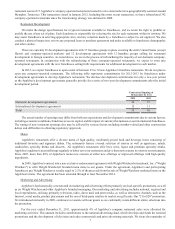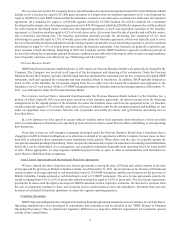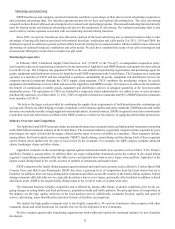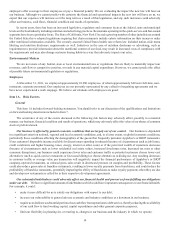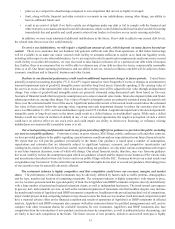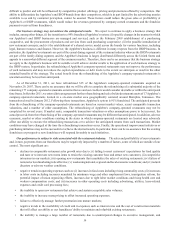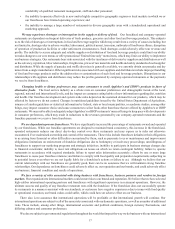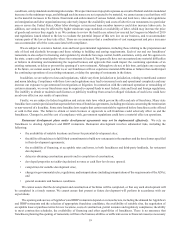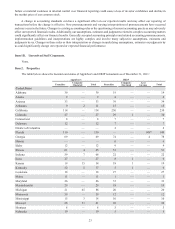IHOP 2011 Annual Report Download - page 32
Download and view the complete annual report
Please find page 32 of the 2011 IHOP annual report below. You can navigate through the pages in the report by either clicking on the pages listed below, or by using the keyword search tool below to find specific information within the annual report.14
employers offer coverage to their employees or pay a financial penalty. We are evaluating the impact the new law will have on
our business. Although we cannot predict with certainty the financial and operational impacts the new law will have on us, we
expect that our expenses will increase over the long term as a result of this legislation, and any such increases could adversely
affect our business, cash flows, financial condition and results of operations.
In recent years, there has been an increased legislative, regulatory and consumer focus at the federal, state and municipal
levels on the food industry including nutrition and advertising practices. Restaurants operating in the quick-service and fast-casual
segments have been a particular focus. The State of California, New York City and a growing number of other jurisdictions around
the United States have adopted regulations requiring that chain restaurants include calorie information on their menus or make
other nutritional information available. The recently-enacted United States health care reform law included nation-wide menu
labeling and nutrition disclosure requirements as well. Initiatives in the area of nutrition disclosure or advertising, such as
requirements to provide information about the nutritional content of our food, may result in increased costs of compliance with
the requirements and may also change customer buying habits in a way that adversely impacts our sales.
Environmental Matters
We are not aware of any federal, state or local environmental laws or regulations that are likely to materially impact our
revenues, cash flow or competitive position, or result in any material capital expenditure. However, we cannot predict the effect
of possible future environmental legislation or regulations.
Employees
At December 31, 2011, we employed approximately 10,900 employees, of whom approximately 640 were full-time, non-
restaurant, corporate personnel. Our employees are not presently represented by any collective bargaining agreements and we
have never experienced a work stoppage. We believe our relations with employees are good.
Item 1A. Risk Factors.
General
This Item 1A includes forward-looking statements. You should refer to our discussion of the qualifications and limitations
on forward-looking statements included in Item 7.
The occurrence of any of the events discussed in the following risk factors may adversely affect, possibly in a material
manner, our business, financial condition and results of operations, which may adversely affect the value of our shares of common
stock or preferred stock.
Our business is affected by general economic conditions that are largely out of our control. Our business is dependent
to a significant extent on national, regional and local economic conditions, and, to a lesser extent, on global economic conditions,
particularly those conditions affecting the demographics of the guests that frequently patronize Applebee's or IHOP restaurants.
If our customers' disposable income available for discretionary spending is reduced (because of circumstances such as job losses,
credit constraints and higher housing, taxes, energy, interest or other costs) or if the perceived wealth of customers decreases
(because of circumstances such as lower residential real estate values, increased foreclosure rates, increased tax rates or other
economic disruptions), our business could experience lower sales and customer traffic as potential customers choose lower-cost
alternatives (such as quick-service restaurants or fast casual dining) or choose alternatives to dining out. Any resulting decreases
in customer traffic or average value per transaction will negatively impact the financial performance of Applebee's or IHOP
company-operated restaurants, as reduced gross sales result in downward pressure on margins and profitability. These factors
could also reduce gross sales at franchise restaurants, resulting in lower royalty payments from franchisees, and could reduce the
profitability of franchise restaurants, potentially impacting the ability of franchisees to make royalty payments when they are due
and develop new restaurants as called for in their respective development agreements.
Our substantial indebtedness could adversely affect our financial health and prevent us from fulfilling our obligations
under our debt. We have a significant amount of indebtedness which could have important consequences to our financial health.
For example, it could:
• make it more difficult for us to satisfy our obligations with respect to our debt;
• increase our vulnerability to general adverse economic and industry conditions or a downturn in our business;
• require us to dedicate a substantial portion of our cash flow from operations to debt service, thereby reducing the availability
of our cash flow to fund working capital, capital expenditures and other general corporate purposes;
• limit our flexibility in planning for, or reacting to, changes in our business and the industry in which we operate;





